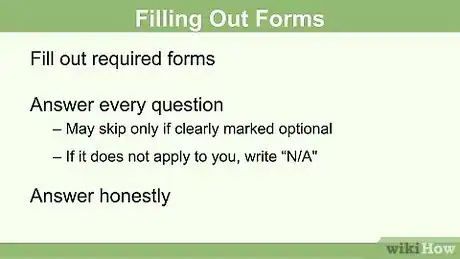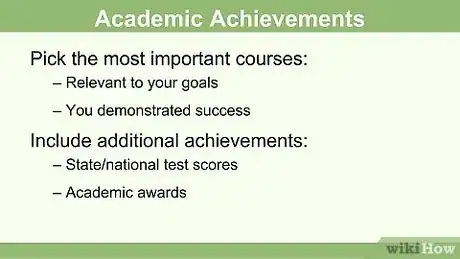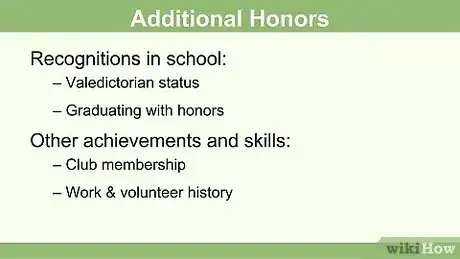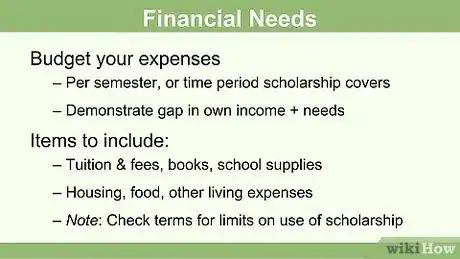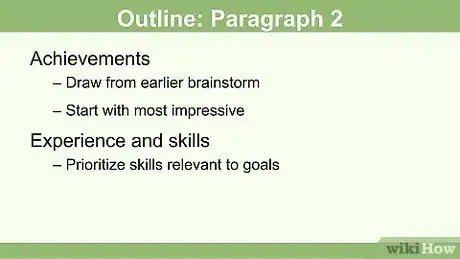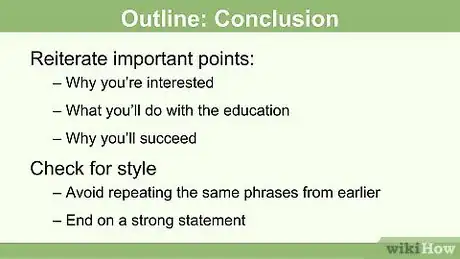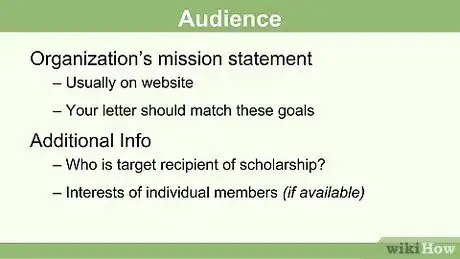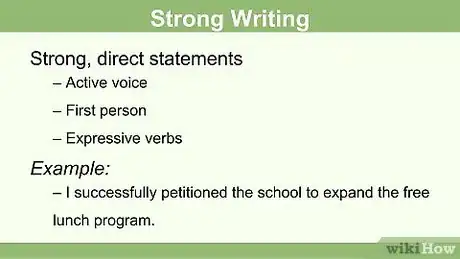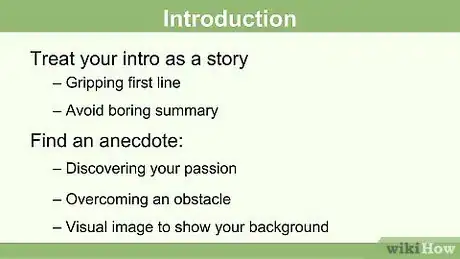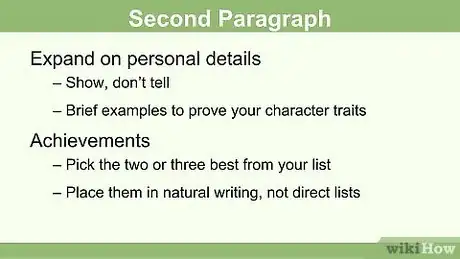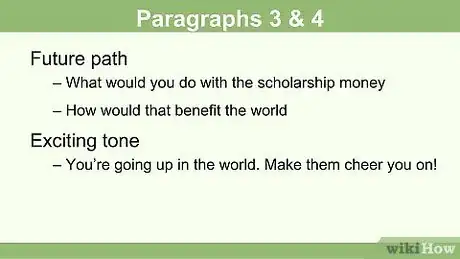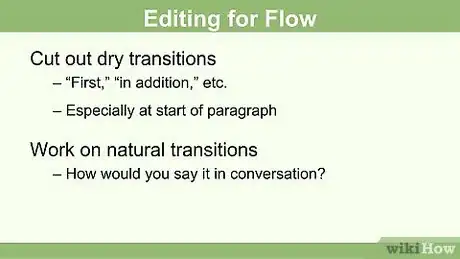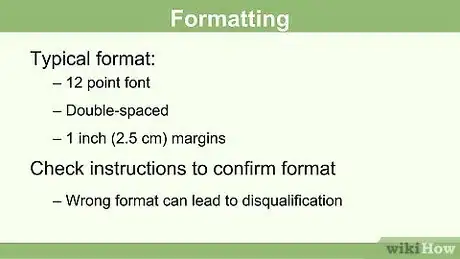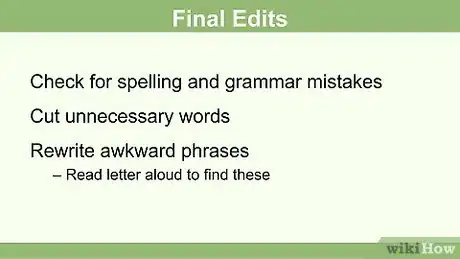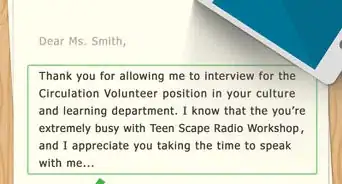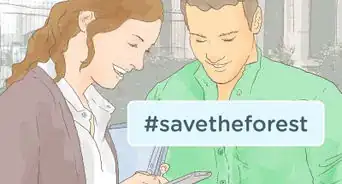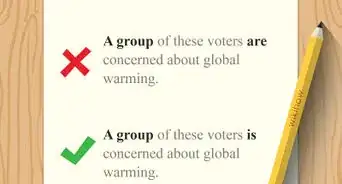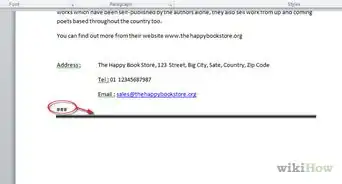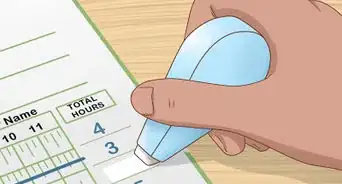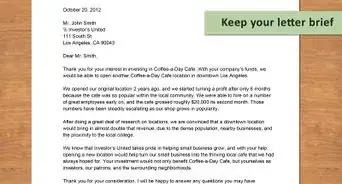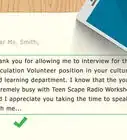This article was co-authored by Megan Morgan, PhD. Megan Morgan is a Graduate Program Academic Advisor in the School of Public & International Affairs at the University of Georgia. She earned her PhD in English from the University of Georgia in 2015.
This article has been viewed 366,027 times.
With tuition, room and board, and books/supplies costs continuing to rise, an undergraduate or graduate degree can get pretty expensive. There are a lot of scholarships out there that can help you pay for those costs, however, and writing a letter asking for scholarship money is your primary source for success in the process. Your letter needs to convince the scholarship committee that you not only have the initiative and leadership necessary to successfully complete the college program that you are seeking to obtain financial support for but that you will be a proud addition to the success of the scholarship program.
Steps
Preparing to Apply
-
1Learn the requirements. Now that you’ve identified your scholarships you will find that there are often different, specific requirements for each, including forms. Print out these requirements and paperclip each scholarship’s list and gathered material separate from all other scholarship applications. Keeping everything separate will make the process infinitely faster.
- Most forms, if not all, will be downloadable via the Internet.
- Make sure when you download them that you paperclip them with the correct scholarship and gathered supporting information.
-
2Fill out forms. Make sure you are providing an answer to every question. Leaving something blank is pretty much a guarantee for disqualification. This goes for honesty as well. Fudging answers can lead to immediate and automatic denial.Advertisement
-
3Don’t rush. As the saying goes, haste makes waste. There’s no faster or easier way to do this. Take your time and do it right. It will pay off in the end.
- Keep in mind that any question requiring a lengthy or well thought-out response should be flagged and held for later. Always take the proper time to think about the best possible answer.
- Once you’ve thought about it, write out a practice version first, then go and fill your final answer in.
Gathering Information
-
1Prepare once, use repeatedly. You will need the same basic information for every single letter you write, regardless of the recipient. That means a job well done now creates a faster and less intensive process later on. [1]
- When you write your second letter, third letter, and so on, you will use the 5 paragraph essay structure for each and simply highlight different information to more accurately fit each recipient.
-
2Write your academic and career goals. Rewrite them until you can state them in one sentence. Now you have a clear, concise plan for your future as well as an important reason for applying for your scholarships.
- Make sure these are clear and specific. "I want to go to medical school and become a doctor" is fine, but it isn't as specific as "I want to attend Johns Hopkins and become an obstetrician serving rural areas."
-
3Prioritize your academic achievements. Identify what courses/fields of study in your past performance are directly related to your future academic/career goals. Now, take those that are the most relevant and in which you have had the most success and put them at the top. You will highlight these in your letter.
-
4Focus on your strengths and leadership skills. Write down everything you have done that can outline the depth and breadth of your skills and potential. Include academic achievements you may have earned such as being valedictorian, school club president, or graduating with honors as well as non-academic activities such as work history, volunteer/community work, awards, sports honors/awards, and internships. Include anything that shows your strength and potential as a leader.
-
5List your needs. Scholarship committees don’t want to hear about how much you need the money. They want to know that you know how to use it. So make a list that shows them you do. For instance:
- Tuition
- Books
- Housing
- Supplies
- Fees
Writing an Outline
-
1Organize your paragraphs. Use the standard five paragraph essay format. This format will structure your letter in a clear, concise, and compelling manner. It consists of an introductory paragraph, three main body paragraphs, and a conclusion. [2]
-
2Outline your introduction. Your introduction should focus on your immediate educational and career goals. This sentence is already written in your preparation stage so you should be able to place it right into this part of your outline. You will briefly discuss how your particular interests within your chosen field of study developed and state why you want to continue your education.
- Remember that these bullet points are for your reference so you can see just how much you’ve accomplished thus far. When you write, it’ll be up to you to turn this list into a compelling "story".[3]
-
3Create bullets for paragraph two. In this paragraph you will focus on your strengths and leadership skills including academic achievements, extracurricular activities, community and/or volunteer, and awards. Again, you have these listed. Now put them in a bulleted list here.
- Were you class president? Did you write a story that won a competition? Did you write for the school newspaper? Were you captain of the Lacrosse team? Did you volunteer in a political campaign or at the food bank? Do you hold down a job with management responsibilities? Do you work with kids? Have you been nominated for academic awards?
-
4Create bullets for paragraph three. This paragraph will develop your reason for applying for this particular scholarship and why you should be considered. Be professional and direct and do not say that you need the scholarship money but rather mention what you will be using it for. Examples would be to help pay for tuition, housing, books and supplies.
- This is the part of the story about the future. How do your goals and vision match up with theirs? And what would you pay for if you had that opportunity?
-
5Create bullets for paragraph four. Now that you’ve told them about yourself, show them that you are deserving of their scholarship and how you will wisely use their funds. Highlight your ability to successfully complete the college program for which you are requesting a scholarship as well as a clear intention on what you plan to do with your course of study. Remember: you are investment. They want to know you'll pay off.
- This an expansion of your introductory paragraph regarding your academic and career goals. Now you provide greater detail that illuminates just how strong your knowledge and passion are and how you could you change your life and the lives of others with this scholarship.
- You’ve already shown them who you are, "now show them who you will become and how that will benefit them".
-
6Outline your conclusion. Reiterate within this closing paragraph your interests in applying for the scholarship. Then explain what you – and by extension they – will gain from you having received this particular award. Remember, they want to award successful candidates. Their success going forward is contingent on choosing candidates who successfully complete their education and move on to productive careers. Be sure you let them know this is exactly your plan.
- Be careful not to use redundant words or phrases from earlier paragraphs.
- Think of this paragraph as one in which you are paraphrasing an article, paragraph, or even a book: summarize but do it in a different way. Make it new, unique, and fresh. As they say, “Take it to the next level.”
Writing Your Letter
-
1Determine your audience. Do a little research on the organization's website before you write your individualized letter. See if you can find their goals or mission statement. Often, these will influence their decisions when awarding scholarship money. Keep your audience in mind as you develop the letter. If you are creating a letter to the National Engineer’s Association, for example, what you highlight will be different than your letter to the NAACP. [4]
-
2Flesh out each paragraph. You have all the information you need already organized and ready to go. Create strong, dynamic and clear sentences that capture the essence of each paragraph concisely.
- Use active voice. Passive voice puts you, the "do"er, last: "Being elected as class president was a highlight of my high school career." Instead, phrase this actively, focusing on what you accomplished: "As class president, I focused on developing a peer anti-bullying group."
- Use expressive action verbs. Instead of saying "I volunteered at Habitat for Humanity," use action verbs that say exactly what you did: "I coordinated volunteers from my high school and helped construct houses for Habitat for Humanity."
-
3Avoid the “introduction is a summary” pitfall. Your first paragraph is not a summary. You want to grab their attention from the get-go with your introduction and a summary won’t get the job done. Approach it like you’re telling the beginning of a story to your friends so they'll "need" to know what happens next.
- Remember the art of the Hollywood thriller: what comes next? If you telegraph where your introduction is going (e.g., by summarizing what follows) you will capture their interest and make them want to read to find out “what happens next.”
- A descriptive short anecdote is often very effective. For example, you could start off telling about the time you held your mom's hand as she screamed in the hospital room. You could describe how you felt as your baby sibling came into the world. Then follow it up with your goal statement: "This experience made me realize that I am called to serve rural communities as an OB/GYN."
-
4Build on your introduction’s mystery. Make sure your second paragraph keeps the mystery and suspense going. Who are you? Where have you been? What have you done? What sets you apart? What is so unique about your story? At the risk of answering a rhetorical question, "you" are what makes your story unique.
- Remember, you intrigued them with the introduction so don’t fall into the “summarize my strengths and leadership skills” trap in paragraph 2. You may choose one, two, or at most three to highlight, "'choosing those that directly reflect the scholarship’s purpose"'.
- Think of your overall strengths/leadership skills as a theme that infuses your second paragraph. It’s not about making a list, it’s about painting a picture. Show them "who you are" (create a narrative paragraph), don’t "tell them" who you are (make a list).
- Be specific! Don't say "I'm a people person." Say "In my job at the grocery store, I have never met a stranger. I strike up chats with each customer and have often been commended for my friendliness."
-
5Structure paragraphs 3 and 4 like a symphony’s crescendo. First show them what you would do with their scholarship now (degree, course load, tuition, room & board, etc.) and then show them how it would benefit everyone in the future.
- Imagine you’re the underdog in a sports movie. You’re Rocky Balboa. You’re Daniel "Rudy" Ruettiger. You have it all – everything except that one big break. You’re ready to grab that break and become a champion. Are they ready to give it to you? If so, THIS IS WHAT HAPPENS!
-
6Use strong transitions between paragraphs. Avoid dry, momentum-killing transitions like, “First,” “Second,” “In addition,” “In conclusion,” etc. Make each paragraph flow naturally into the next like it would in a conversation. The most compelling writing is the writing that makes the reader want to read the next line rather than reading a by-wrote list of why they should be reading.
- A natural flow in a story never uses these types of clunky transitions and your letter is a story. Look at it that way and transitions become much easier.
-
7Keep each paragraph short and to the point. Remember, you only have two pages maximum. That means each paragraph can’t be much more than one-third of a page. Be pointed, be brief, and be strong.[5]
-
8Format your letter. Use a 12-point font type, double-spaced so that it is easy to read. Use professional quality stationery paper if you plan on mailing the letter using the postal service.
- If the organization has given you specific requirements for the letter. follow them precisely. It would be a shame if your essay is DQ'ed straight out of the gate for being too long or in the wrong font.
-
9Read and review your letter. This should be done numerous times to check for grammar, typos, layout, organization, and clarity. If you can say something in 12 words instead of 20 then do so. Add or delete content and check for proper punctuation each and every time you read it. Make any needed corrections and edit where necessary.
Community Q&A
-
QuestionI need a letter to apply for a scholarship to a medical university for my post graduation. What can I do?
 Community AnswerRead the university's requirements for the letter first. Then, you can follow the steps outlined in this article.
Community AnswerRead the university's requirements for the letter first. Then, you can follow the steps outlined in this article. -
QuestionHow do I get a sponsorship letter?
 Community AnswerThe article points out that you can usually download the forms from the institution.
Community AnswerThe article points out that you can usually download the forms from the institution.
Warnings
- Do not mention personal problems as a reason for requesting the scholarship.⧼thumbs_response⧽
- Avoid using slang or inappropriate language.⧼thumbs_response⧽
- Reputable organizations offering scholarships don’t charge you a fee for applying. Avoid those that do.⧼thumbs_response⧽
References
- ↑ http://www.usnews.com/education/blogs/the-scholarship-coach/2013/01/31/4-ways-to-make-your-scholarship-essay-stand-out
- ↑ http://www.englishdiscourse.org/5.paragraph.essay.format.html
- ↑ http://www.usnews.com/education/blogs/the-scholarship-coach/2010/12/16/skip-these-6-scholarship-essay-errors
- ↑ https://www.owens.edu/writing/scholarship.html
- ↑ http://www.financialaidtips.org/scholarships.htm
About This Article
To write a letter asking for scholarship money, begin with a compelling personal anecdote, then explain why this story relates to your goals. In your first body paragraph, briefly describe 2-3 of your major accomplishments, and how those experiences shaped you. Then, use the third and fourth paragraphs to explain what you’d use the money for, and what you will accomplish in the future if you’re given the opportunity. In your conclusion, re-visit your opening anecdote and describe how it relates to the organization’s goals and mission statement. For some strategies you can use to outline and edit your letter, keep scrolling!

